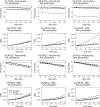Design and analysis considerations for combining data from multiple biomarker studies
- PMID: 30569596
- PMCID: PMC6755899
- DOI: 10.1002/sim.8052
Design and analysis considerations for combining data from multiple biomarker studies
Abstract
Pooling data from multiple studies improves estimation of exposure-disease associations through increased sample size. However, biomarker exposure measurements can vary substantially across laboratories and often require calibration to a reference assay prior to pooling. We develop two statistical methods for aggregating biomarker data from multiple studies: the full calibration method and the internalized method. The full calibration method calibrates all biomarker measurements regardless of the availability of reference laboratory measurements while the internalized method calibrates only non-reference laboratory measurements. We compare the performance of these two aggregation methods to two-stage methods. Furthermore, we compare the aggregated and two-stage methods when estimating the calibration curve from controls only or from a random sample of individuals from the study cohort. Our findings include the following: (1) Under random sampling for calibration, exposure effect estimates from the internalized method have a smaller mean squared error than those from the full calibration method. (2) Under the controls-only calibration design, the full calibration method yields effect estimates with the least bias. (3) The two-stage approaches produce average effect estimates that are similar to the full calibration method under a controls only calibration design and the internalized method under a random sample calibration design. We illustrate the methods in an application evaluating the relationship between circulating vitamin D levels and stroke risk in a pooling project of cohort studies.
Keywords: aggregation; between-study variability; calibration; pooling project; two-stage method.
© 2018 John Wiley & Sons, Ltd.
Conflict of interest statement
CONFLICT OF INTEREST
None to report.
Figures


Similar articles
-
Spline Analysis of Biomarker Data Pooled from Multiple Matched/Nested Case-Control Studies.Cancers (Basel). 2022 Jun 3;14(11):2783. doi: 10.3390/cancers14112783. Cancers (Basel). 2022. PMID: 35681763 Free PMC article.
-
Statistical methods for biomarker data pooled from multiple nested case-control studies.Biostatistics. 2021 Jul 17;22(3):541-557. doi: 10.1093/biostatistics/kxz051. Biostatistics. 2021. PMID: 31750898 Free PMC article.
-
STATISTICAL METHODS FOR ANALYSIS OF COMBINED CATEGORICAL BIOMARKER DATA FROM MULTIPLE STUDIES.Ann Appl Stat. 2020 Sep;14(3):1146-1163. doi: 10.1214/20-aoas1337. Epub 2020 Sep 18. Ann Appl Stat. 2020. PMID: 33633815 Free PMC article.
-
Evaluation of instrument error and method agreement.AANA J. 1996 Jun;64(3):261-8. AANA J. 1996. PMID: 9095698 Review.
-
Methods to account for uncertainties in exposure assessment in studies of environmental exposures.Environ Health. 2019 Apr 8;18(1):31. doi: 10.1186/s12940-019-0468-4. Environ Health. 2019. PMID: 30961632 Free PMC article. Review.
Cited by
-
Spline Analysis of Biomarker Data Pooled from Multiple Matched/Nested Case-Control Studies.Cancers (Basel). 2022 Jun 3;14(11):2783. doi: 10.3390/cancers14112783. Cancers (Basel). 2022. PMID: 35681763 Free PMC article.
-
Circulating vitamin D and breast cancer risk: an international pooling project of 17 cohorts.Eur J Epidemiol. 2023 Jan;38(1):11-29. doi: 10.1007/s10654-022-00921-1. Epub 2023 Jan 3. Eur J Epidemiol. 2023. PMID: 36593337 Free PMC article.
-
Development and validation of a novel combinational index of liquid biopsy biomarker for longitudinal lung cancer patient management.J Liq Biopsy. 2024 Sep 10;6:100167. doi: 10.1016/j.jlb.2024.100167. eCollection 2024 Dec. J Liq Biopsy. 2024. PMID: 40027304 Free PMC article.
-
A New Pipeline for the Normalization and Pooling of Metabolomics Data.Metabolites. 2021 Sep 17;11(9):631. doi: 10.3390/metabo11090631. Metabolites. 2021. PMID: 34564446 Free PMC article.
-
Statistical methods for biomarker data pooled from multiple nested case-control studies.Biostatistics. 2021 Jul 17;22(3):541-557. doi: 10.1093/biostatistics/kxz051. Biostatistics. 2021. PMID: 31750898 Free PMC article.
References
-
- Smith-Warner S, Spiegelman D, Ritz J, et al. Methods for pooling results of epidemiologic studies the pooling project of prospective studies of diet and cancer. Am J Epidemiol 2006;163(11):1053–1064. - PubMed
-
- Tworoger S, Hankinson S. Use of biomarkers in epidemiologic studies: minimizing the influence of measurement error in the study design and analysis. Cancer Causes Control. 2006;17(7):889–899. - PubMed
Publication types
MeSH terms
Substances
Grants and funding
LinkOut - more resources
Full Text Sources
